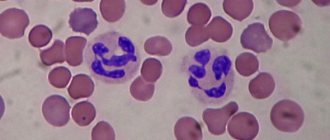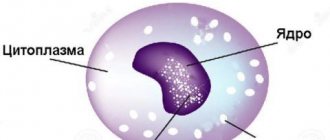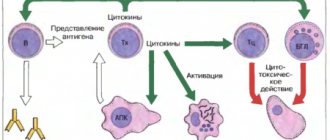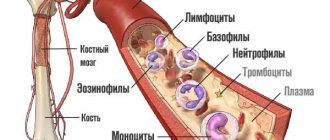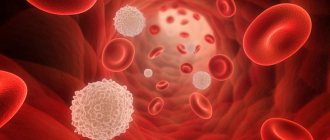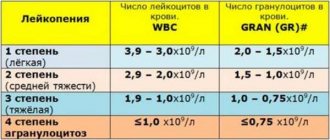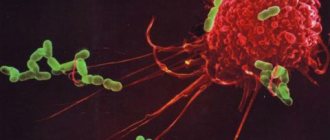What kind of cells are neutrophils?
Neutrophilic leukocytes or neutrophils are the most numerous type of white blood cells.
They are formed in the bone marrow, where they undergo a series of stages during maturation. A myeloblast is formed from a precursor cell. The next cell is the promyelocyte. From it a myelocyte is formed, and then a metamyelocyte. These neutrophils are called juveniles. From them, rod forms mature. Further, mature cells – segmented neutrophils – are formed from them.
All types of neutrophil leukocytes differ from each other at different stages: the shape of the nucleus, the presence of granules. For example, segmented neutrophils contain a nucleus divided into segments.
The granules contained in the cytoplasm of neutrophils provide their ability to perform their biological functions.
The presence of granules in the cytoplasm of neutrophils allows them to be classified as granulocytic leukocytes. In addition to neutrophils, they also include eosinophils and basophils.
The main task of these cells is to fight foreign agents that enter our body. Therefore, there is a relationship between the content of these leukocytes and the presence of an infectious process.
Photo: https://moyakrov.info/blood/prichiny-povysheniya-ili-ponizheniya-segmentoyadernyh-nejtrofilov
Functions of leukocytes
The basis of the human body's immune system are leukocytes, which come in several types. These blood cells prevent infection from infecting healthy cells.
Leukocytes are divided into several types with different functions:
- T-lymphocytes guarantee cell immunity and eliminate foreign microorganisms and defects. In addition, they provide resistance to infections, promote blood formation, and also control the functions of B lymphocytes.
- B lymphocytes protect the body from bacterial and viral infections by producing antibodies. Cells of this type give the immune system the ability to remember. Once, faced with a harmful microorganism, information about it is postponed, and along with it, methods for its destruction. Subsequently, the cells transmit information by inheritance.
- Monocytes are the orderlies of the immune system, absorbing parasitic remains of the products of active cell activity. They not only cleanse the body of pests, but also transmit information about them to new cells.
When leukocytes work together and properly, the human body is maintained in a healthy state.
Leukocytes, according to their morphological properties, are divided into 2 units:
- granulocytes are granular particles of blood, the main of which are neutrophils;
- agranulocytes.
The number of lymphocytes in the blood is an important indicator of a healthy body. Reduced levels indicate immunodeficiency, while high values indicate autoimmune abnormalities or excessive immune function. The reasons for deviations are found only with additional research.
Norms for neutrophil levels in children
The normal content of neutrophils in children is presented in Table 1. There are two main types of neutrophil leukocytes: band and segmented. Also, the units of measurement of a given type of cell will be presented in the form of relative and absolute values.
Absolute values show the content of a given cell type in the blood, expressed as 10 * 9 per liter. Relative numbers show how many cells of a given type were detected out of 100. Then the unit of measurement will be percentages.
Table 1. Norm of neutrophils in children.
| Age group | Absolute values | Relative values | |
| Rod | Segmented | ||
| Less than one year | 1.5 – 8.5 * 10*9/liter | 0,5 – 4 % | 15 – 45 % |
| One year – six years | 1.5 – 8.5 * 10*9/liter | 0,5 – 5 % | 25 – 60 % |
| From seven to twelve years | 1.8 – 8 * 10*9/liter | 0,5 – 5 % | 35 – 65 % |
| Over thirteen years old | 1.8 – 7.7 * 10*9/liter | 0,5 – 6 % | 47 – 72 % |
Why are neutrophils low in a child?
The majority of neutrophils are segmented. Therefore, the reasons that segmented cells are reduced may be:
- disruption of the formation of neutrophil leukocytes in the bone marrow , for example, as a result of a malignant process;
- rapid death of neutrophils after performing their function - destroying the infectious agent. That is, with an excess of pathogenic agents, the body does not have time to produce new cells, their content decreases;
- a change in the number of other types of white blood cells , resulting in a change in the relative importance of the cells. Therefore, in this case it is better to take into account the absolute values of cells in the blood.
A decrease in the number of neutrophil leukocytes is called neutropenia.
Thus, the presence of some infectious diseases is accompanied by the fact that segmented neutrophils are reduced in children. Examples of such diseases may be:
- rubella;
- hepatitis;
- chickenpox;
- flu;
- fungal infection and others.
Photo: https://pixabay.com/photos/cold-headaches-health-influence-3861935/
Symptoms of decline
If neutrophils are low due to the development of a viral or bacterial infection, protozoal disease or metabolic pathology, tumor formation, symptoms of the disease that caused the change in tests will appear.
Neutropenia, which occurs due to vitamin deficiency or physical fatigue, does not manifest itself by any external clinical signs. Also, as in the case of congenital neutropenia, only test results indicate a deviation from the norm.
Important information: Where platelets are formed and destroyed in humans (which organ produces them)
If the decrease in the level of neutrophil cells has not reached a critical value, it means that the body has enough resources to protect itself. Other leukocytes are able to perform the protective functions of neutrophils, but the fight against infection in such conditions takes longer.
A lack of these types of white blood cells can lead to unpleasant health consequences. With such a violation, there is a possibility of the disease becoming chronic, because There are not enough neutrophil cells in the body to neutralize the source of inflammation. Decreased immunity, characteristic of the state of neutropenia, increases the risk of contracting an infection in crowded places and leads to the accelerated spread of bacteria and viruses in the body.
In severe neutropenia, when neutrophil cells are practically absent in the blood, the body does not respond to the proliferation of pathogenic microorganisms. In this case, there is a rapid increase in the specific symptoms of the disease.
When children are referred for testing
Determining the level of neutrophils in the blood is included in such an indicator as the leukocyte formula. It involves counting the types of leukocytes. The calculation of the leukocyte formula is most often included in the CBC (general clinical blood test).
The purpose of this blood test is to:
- assess the child’s condition in the absence of any complaints during a routine examination;
- identify the presence of an infectious process if it is suspected, especially when there are clinical manifestations;
- identify disorders of blood cell content as a result of a hereditary disorder or tumor process.
That is, the CBC is a simple but quite informative blood test, which is prescribed for preventive purposes, as well as for any disease.
Forecast
The prognosis is influenced by the degree of damage and timeliness of treatment. If the disease is mildly benign, then a cure is guaranteed. If the disease is caused by a malignant tumor, nothing can be predicted. According to statistics, for 20% of such patients the prognosis is unfavorable.
Today, many medical centers use modern techniques, with which results can be obtained very quickly. Sometimes doctors resort to surgery, bone marrow transplantation. A successful operation guarantees a good prognosis for the treatment of the disease. Neutropenia of this type has a very small percentage of the likelihood of the body contracting an infection.
Neutrophils in the blood of an adult suffering from a congenital disease are significantly reduced. To bring them back to normal, the patient needs long-term preventive treatment. Regularly after antiviral therapy, the patient must be examined, namely, a blood test for the absolute number of neutrophils and leukocytes.
Article design: Mila Friedan
Preparing for analysis
In order to find out the number of neutrophil leukocytes, you need to donate blood from a finger or from a vein. This biological material must be taken on an empty stomach in children over five years of age. It is recommended not to feed infants for 30 minutes before blood sampling, and for children under five years old - for 3 to 4 hours.
It is also desirable that the patient does not experience emotional overload. Parents should motivate their child to withstand the “finger prick” and explain that there is nothing wrong with it.
Parents should also make sure that the child does not run around the hospital corridors before the blood is drawn.
The baby's hands should be warm. If they are cold, blood will flow poorly from the finger, causing discomfort to the medical staff and the child.
Photo: https://pixabay.com/photos/nurse-diabetes-diabetic-test-a1c-527615/
Why is neutropenia dangerous?
The danger of neutropenia is that the pathology can intensify the course of the primary disease. The child may develop serious purulent lesions of the mucous membranes of the mouth, nose, etc., as well as internal organs, which can lead to the development of toxic shock. If this situation is ignored, the risk of developing blood poisoning (sepsis) increases, and in most cases, sepsis ends in the death of the child.
As already mentioned, chronic benign neutropenia is not dangerous, and the baby is removed from the dispensary register within 2-3 years after the diagnosis of the pathology.
If neutropenia occurs simultaneously with a bacterial infection, neutrophilic leukemia cannot be excluded, which very quickly transforms into leukopenia.
Article on the topic:
Calcium levels in blood tests for women depending on age
In some cases, if the disease is difficult to treat or is associated with frequent severe bronchitis and pneumonia, and also if the child, due to neutropenia, lags behind in physical and mental development, he may be assigned a disability.
Method for determining the level of neutrophils in the blood
Most analyzes in a modern laboratory are performed by analyzers. Determination of the number of neutrophils can be done on an automatic hematology analyzer.
Another option for determining the number of neutrophil leukocytes is the manual method of calculating the leukocyte formula. A blood smear is made and stained with special dyes that allow different types of white blood cells to be identified among each other.
The microscope is then used to count 100 cells per field of view, noting which cells are seen. Then the relative value of each leukocyte found in the smear is indicated.
In a blood smear you can see different degrees of maturity of neutrophils, as well as basophils, eosinophils, lymphocytes, monocytes, and morphological features of red blood cells (size and shape).
How to increase the level of protective bodies?
In order to identify the exact cause of the disorders, additional examinations of the body will be required. The doctor may order an ultrasound of internal organs, a bone marrow CT scan, a biochemistry test, etc. In addition, according to the general AK, they look at the shift in the leukocyte formula. Health status should never be assessed solely by one indicator.
The purpose of studying the leukocyte formula is to differentiate the etiology of disorders:
- Immunity status;
- The presence of leukemia or other blood diseases;
- The severity of the disease;
- Concomitant helminthic infestation or allergic reaction;
- Viral or bacterial infections;
- Radiation sickness;
- Anemia;
- Diseases of the liver/kidneys, thyroid gland.
It is possible to increase NEU only after determining the true pathology in the body. After diagnosis in adults or children, the patient is prescribed a course of therapy. Most often, antibacterial agents are required to destroy the main pathogenic agent. Next, immunostimulants and vitamin complexes are used to increase the patient’s immunity.
To increase band NEU in hematopoietic disorders, longer treatment will be required. It is prescribed by a hematologist. And functional disorders of the thyroid gland, kidneys and liver are restored by an endocrinologist and therapist.
Analysis transcript
Interpretation of the study results should only be carried out by a doctor. He will take into account all the nuances:
- what is the child’s condition at the time of treatment;
- are there any complaints;
- data from other blood or urine tests;
- child examination data;
- heredity.
In laboratory practice, high and low neutrophil values occur. It has already been indicated above what reasons may contribute to a low level of neutrophils in the blood.
A high level of neutrophils indicates that at this moment the body is fighting an infection. All the “fighters” went to fight the pathogenic agent. And this condition is called neutrophilosis.
